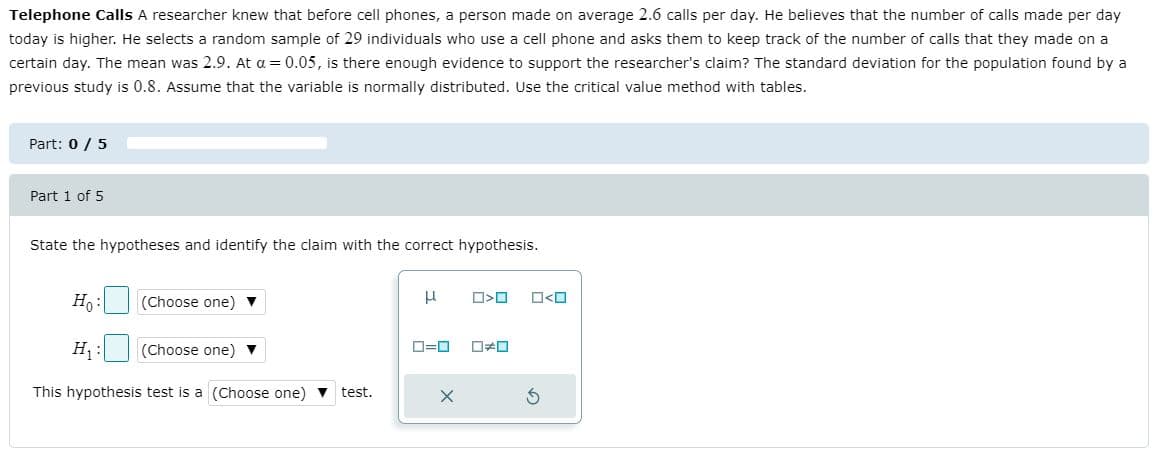Telephone Calls A researcher knew that before cell phones, a person made on average 2.6 calls per day. He believes that the number of calls made per day today is higher. He selects a random sample of 29 individuals who use a cell phone and asks them to keep track of the number of calls that they made on a certain day. The mean was 2.9. At a = 0.05, is there enough evidence to support the researcher's claim? The standard deviation for the population found by a previous study is 0.8. Assume that the variable is normally distributed. Use the critical value method with tables. Part: 0 / 5 Part 1 of 5 State the hypotheses and identify the claim with the correct hypothesis. Ho: (Choose one) ▼ H1 (Choose one) v O=D This hypothesis test is a (Choose one) v test.
Telephone Calls A researcher knew that before cell phones, a person made on average 2.6 calls per day. He believes that the number of calls made per day today is higher. He selects a random sample of 29 individuals who use a cell phone and asks them to keep track of the number of calls that they made on a certain day. The mean was 2.9. At a = 0.05, is there enough evidence to support the researcher's claim? The standard deviation for the population found by a previous study is 0.8. Assume that the variable is normally distributed. Use the critical value method with tables. Part: 0 / 5 Part 1 of 5 State the hypotheses and identify the claim with the correct hypothesis. Ho: (Choose one) ▼ H1 (Choose one) v O=D This hypothesis test is a (Choose one) v test.
MATLAB: An Introduction with Applications
6th Edition
ISBN:9781119256830
Author:Amos Gilat
Publisher:Amos Gilat
Chapter1: Starting With Matlab
Section: Chapter Questions
Problem 1P
Related questions
Topic Video
Question

Transcribed Image Text:Telephone Calls A researcher knew that before cell phones, a person made on average 2.6 calls per day. He believes that the number of calls made per day
today is higher. He selects a random sample of 29 individuals who use a cell phone and asks them to keep track of the number of calls that they made on a
certain day. The mean was 2.9. At a = 0.05, is there enough evidence to support the researcher's claim? The standard deviation for the population found by a
previous study is 0.8. Assume that the variable is normally distributed. Use the critical value method with tables.
Part: 0 / 5
Part 1 of 5
State the hypotheses and identify the claim with the correct hypothesis.
Ho:
(Choose one) v
H1
(Choose one) v
D=0
This hypothesis test is a (Choose one) v test.
Expert Solution
This question has been solved!
Explore an expertly crafted, step-by-step solution for a thorough understanding of key concepts.
This is a popular solution!
Trending now
This is a popular solution!
Step by step
Solved in 2 steps

Knowledge Booster
Learn more about
Need a deep-dive on the concept behind this application? Look no further. Learn more about this topic, statistics and related others by exploring similar questions and additional content below.Recommended textbooks for you

MATLAB: An Introduction with Applications
Statistics
ISBN:
9781119256830
Author:
Amos Gilat
Publisher:
John Wiley & Sons Inc

Probability and Statistics for Engineering and th…
Statistics
ISBN:
9781305251809
Author:
Jay L. Devore
Publisher:
Cengage Learning

Statistics for The Behavioral Sciences (MindTap C…
Statistics
ISBN:
9781305504912
Author:
Frederick J Gravetter, Larry B. Wallnau
Publisher:
Cengage Learning

MATLAB: An Introduction with Applications
Statistics
ISBN:
9781119256830
Author:
Amos Gilat
Publisher:
John Wiley & Sons Inc

Probability and Statistics for Engineering and th…
Statistics
ISBN:
9781305251809
Author:
Jay L. Devore
Publisher:
Cengage Learning

Statistics for The Behavioral Sciences (MindTap C…
Statistics
ISBN:
9781305504912
Author:
Frederick J Gravetter, Larry B. Wallnau
Publisher:
Cengage Learning

Elementary Statistics: Picturing the World (7th E…
Statistics
ISBN:
9780134683416
Author:
Ron Larson, Betsy Farber
Publisher:
PEARSON

The Basic Practice of Statistics
Statistics
ISBN:
9781319042578
Author:
David S. Moore, William I. Notz, Michael A. Fligner
Publisher:
W. H. Freeman

Introduction to the Practice of Statistics
Statistics
ISBN:
9781319013387
Author:
David S. Moore, George P. McCabe, Bruce A. Craig
Publisher:
W. H. Freeman